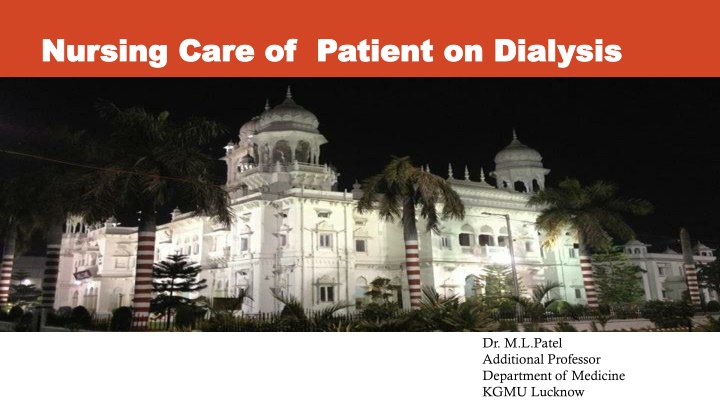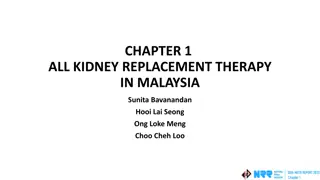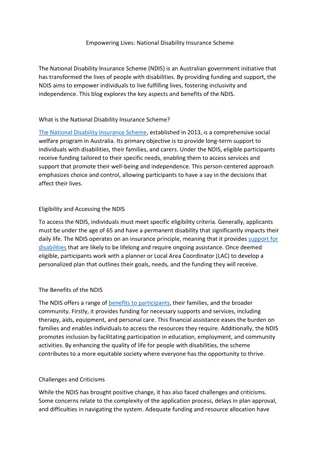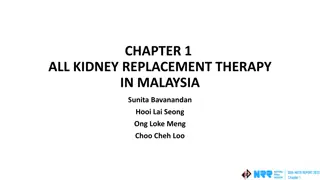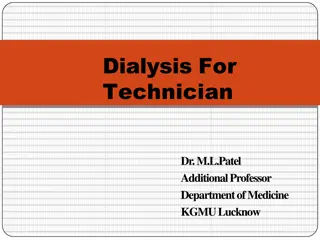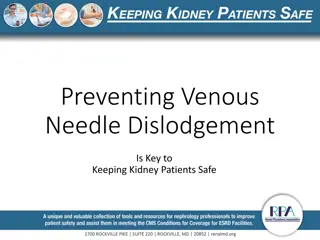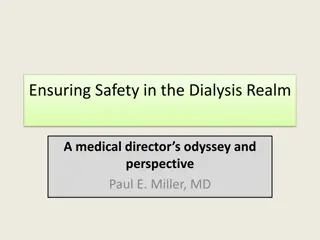Comprehensive Overview of Nursing Care for Dialysis Patients
Detailed information about providing nursing care for patients on dialysis, including protocols for machine use, patient care, and investigation, as well as essential aspects of hemodialysis procedures. The content covers access requirements, dialysis machine setup, procedure steps, waste removal, ultrafiltration, and potential complications during hemodialysis. Pre-dialysis care recommendations are also outlined to ensure patient safety and optimal treatment outcomes.
Download Presentation

Please find below an Image/Link to download the presentation.
The content on the website is provided AS IS for your information and personal use only. It may not be sold, licensed, or shared on other websites without obtaining consent from the author.If you encounter any issues during the download, it is possible that the publisher has removed the file from their server.
You are allowed to download the files provided on this website for personal or commercial use, subject to the condition that they are used lawfully. All files are the property of their respective owners.
The content on the website is provided AS IS for your information and personal use only. It may not be sold, licensed, or shared on other websites without obtaining consent from the author.
E N D
Presentation Transcript
Nursing Nursing Care Care of of Patient on Dialysis Patient on Dialysis Dr. M.L.Patel Additional Professor Department of Medicine KGMU Lucknow
Nursing Nursing Care Care of of Patient on Dialysis Patient on Dialysis Protocols In each unit in regard to machines,Procedure & patient care Sanitizing machines PD cath care/dressing /treatment Flushing new PD catheter PET Peritonitis care Investigation protocol Vaccination Records /Treatment flow sheets
Hemodialysis Hemodialysis requires requires 5 5 things things 1. Access to patient s circulation (usually via fistula) 2. Access to a dialysis machine and dialyzer with a semipermeable membrane 3. The appropriate solution (dialysate bath) 4. Time: 12 hours each week, divided in 3 equal segments 5. Place: home (if feasible) or a dialysis centre
Hemodialysis Hemodialysis- - Procedure Procedure 1. Patient s circulation is accessed 2. Unless contraindicated, heparin is administered 3. Dialysis solution surrounds the membranes andflows in the opposite direction. 4. Dialysis solution is: a. Highly purified water b. Na,K, Ca, Mg, Cl, & Dextrose c. Either bicarbonate or acetate, to maintain proper Ph. 6. Via the process of diffusion, wastes are removed in the form of solutes (metabolic wastes, acid-base components and electrolytes)
7. Solute wastes can be discarded 8. Ultrafiltration removes excess water from the blood 9. After cleansing, the blood returns to the client via the access
Access Access during during Hemodialysis Hemodialysis 1. Infection 2. Catheter clotting 3. Central venous thrombosis 4. Stenosis or thrombosis 5. Ischemia of the affected limb 6. Development of an aneurysm
Pre Pre- -dialysis dialysis care care Assess for- Weight: Determines amount of fluid to be removed during dialysis Vital Sign: BP for hypo and hypertension; temperature for sepsis; respiration for fluid Overload Potassium level: Determines potassium level in dialysate (in the chronic setting, this is done monthly unless the patient is symptomatic Hold drugs that pass through the dialysis membrane, such as piperacillin, folic acid, and other water-soluble vitamins. Hold antihypertensive drugs, especially if systolic pressure is below 100, per physician order
Check access site Assess fistula or graft for infection Assess circulation in distal portion of extremity Auscultate for bruit Palpate for thrill No IV or blood draws in that arm No BP in arm
During Dialysis Watch for Hypotension Muscle cramps Nausea and vomiting Headache Itching Less commonly: disequilibrium syndrome, hypersensitivity reaction, arrhythmia, cardiac tamponade, seizures, air embolism
POST DIALYSIS CARE Monitor BP; report hypotension or hypertension Watch for bleeding Check weight and compare (weight loss should be close to fluid removal goal set during treatment) Document unusual findings Assess access site for bruit, thrill, exudate, signsof infection, bleeding Give missed meds, if indicated
NURSHING INTERVENTION IN DIALYSIS 1. Explain procedure to client 2. Cannulating & connecting to HD machine 3. Monitor hemodynamic status continuously 4. Monitor acid-base balance 5. Monitor electrolytes 6. Insure sterility of system 7. Maintain a closed system 8. Diet Restriction- Protein intake, Sodium intake, Potassium intake, Fluid intake 9. Reinforce adjustment to prescribed medications that may be affected by the process of hemodialysis
NURSHING INTERVENTION IN DIALYSIS Gastric ulcers, Hypertension, Calcium deficiencies, Anemia and fatigue, Depression, sexual dysfunction, suicide risk 10. Monitor for complications of dialysis related to: Arteriosclerotic cardiovascular disease Congestive heart failure, Stroke, Infection,
DIET DIET DIALYSIS DIALYSIS PD get calories from Dextrose in the fluid PD patients may eat fewer CHO than hemodialysis patients Protein- HD loses 10-12 gms of Aminoacids and PD 5-15gms of protein per treatment Also compensate infection inflammation anemia -->so consume HBV protein (1gm/Kg/day) Na Salt 2gm/day salt induce thirst High B P, and HF K- 2mg/day K is more efficiently removed in PD(daily treatment)
Phosphorous cause severe bone and heart problems , itching and tissue calcifications (800-1000mg/Day) Ta ke phosphate binders Ca should be more than 2000mg /day. Ca is pulled out by dialysis lead to serious health problems Fluid- if they consume more fluid use concentrated dialysate if no urine out put consume <than 1000ml /day . Consume 20-25 g fiber
1.2 g of protein/kg body weight/day for hemodialysis patients 1.3 g of protein/kg body weight/day for peritoneal dialysis patients 35 kcal/kg body weight for patient less than 60 years of age 30 to 35 kcal/kg body weight For patients 60 years or older
